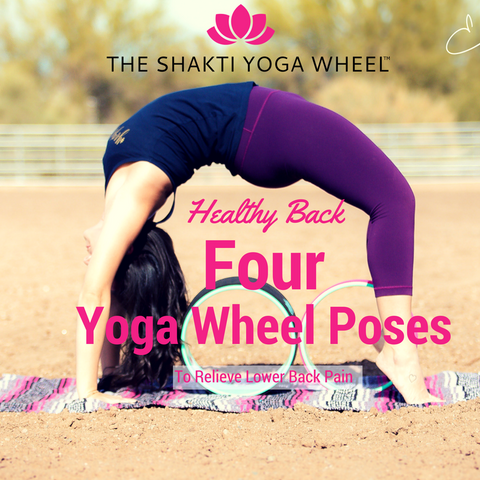4 Yoga Wheel Poses To Relieve Lower Back Pain!
For a lot of Americans the most favorite time of traveling and vacation. Most of us spend a good deal of time in cars, traveling, commuting, chauffeuring kids around, doing errands, or if we’re lucky, heading out to an adventure spot.
Take a moment and think about your posture? How do you sit, how do you drive? Do you round your back?
Round-backed bending is ubiquitous in modern urban culture. It damages the back. Recognizing this, many health advocates recommend bending at the knees. Done to excess or with poor form, this damages the hips, knees, ankles, and feet.
Surprisingly, poor bending form abounds even in fitness and wellness classes.

People sometimes equate being able to touch the toes with flexibility. An imprecise and insistent pursuit of this kind of “flexibility” causes disc damage, hyper-extended spinal ligaments, and a lot of pain. Let’s examine do’s and don’t’s in bending more closely.
DO
 Use your Yoga Wheel to you can accomplish your forward bend pose and focus on a straightening your back.
Use your Yoga Wheel to you can accomplish your forward bend pose and focus on a straightening your back.
1. Be sure your legs are externally rotated so there’s room for your pelvis when you bend.
If your thigh bones (femurs) are in the way of the pelvis settling between the legs in a forward bend, there’s no healthy workaround for bending. Widening your stance can help some, but a healthy bend needs external leg rotation no matter where your legs are positioned.

2. Maintain the shape of your back when bending
The spine carries precious cargo - like all the nerves and nerve roots that exit between the vertebrae - and these are threatened by major distortions of the spine.
In activities other than bending, some movement around a healthy baseline is healthy and desirable. Such movement stimulates circulation and helps maintain healthy spinal tissues.
For bending, I recommend strictly maintaining the baseline shape of the spine. Distorting the spine when bending loads the discs and can cause damage. It also sets a risky pattern for bends that involve weight-bearing. I recommend pure hip-hinging for all bends, whether in daily life or exercise. With practice, good form, and strengthened inner corset muscles, you will be able to move into sustained bending and lifting weights.
3. Maintain (or increase) the length of your spine when bending You don’t want to load your discs when bending. This happens when rounding or swaying the back, or from additional muscle engagement while maintaining your baseline spinal shape. Using the inner corset (go our free download blog post and The Shakti Yoga Wheel Poses - 98 Posture Guide) while bending is excellent insurance against loading the discs unwittingly.
4. Practice bending with a teacher and with mirrors
If you are accustomed to tucking your pelvis, it can be a real challenge to find the correct movement in the hips. Practice bending in front of a mirror or, better yet, with a Shakti Yoga Wheel™ Method teacher, so you get the feel of healthy hip rotation with a straight back.
Start off with small bends - pay attention when you are at the sink or making your bed. Keep your feet and knees pointed out 10-15 degrees, have your knees soft and only bend at the hips as far as you can before you start to round. At that point, enjoy the gentle stretch in your hamstrings and external hip rotators. Bend your knees if you want to go any further.
If you like to try something else to get relief from back pain that travels into your hip joints, here is what we do differently! Most yoga classes, Pilates training, and gym routines teach students to stand with parallel feet. By The Shakti Yoga Wheel™ Method, this constitutes too much of an internal leg rotation. If you observe indigenous people they have their feet facing outward in the range of 5-15 degrees, and their legs are correspondingly externally rotated. If you feel hip pain by hinging forward from your hips with your feet parallel try to rotate your feet slightly outwards to to contribute less stress and arthritic changes in the hip joints, especially when you combine it with forward bends and other hip motions.
How well do you stack up when bending in your daily life and when exercising? How far along are you in your hip-hinging journey?
Learn more? Sign up for our newsletter!
SAVE THE DATE!
REGISTER NOW - The Shakti Yoga Wheel™ Teacher Training, Phoenix, Arizona - September, 22.-24, 2017
REGISTER NOW - The Shakti Yoga Wheel™ Teacher Training, Frankfurt, Germany - June, 02.-03, 2018





